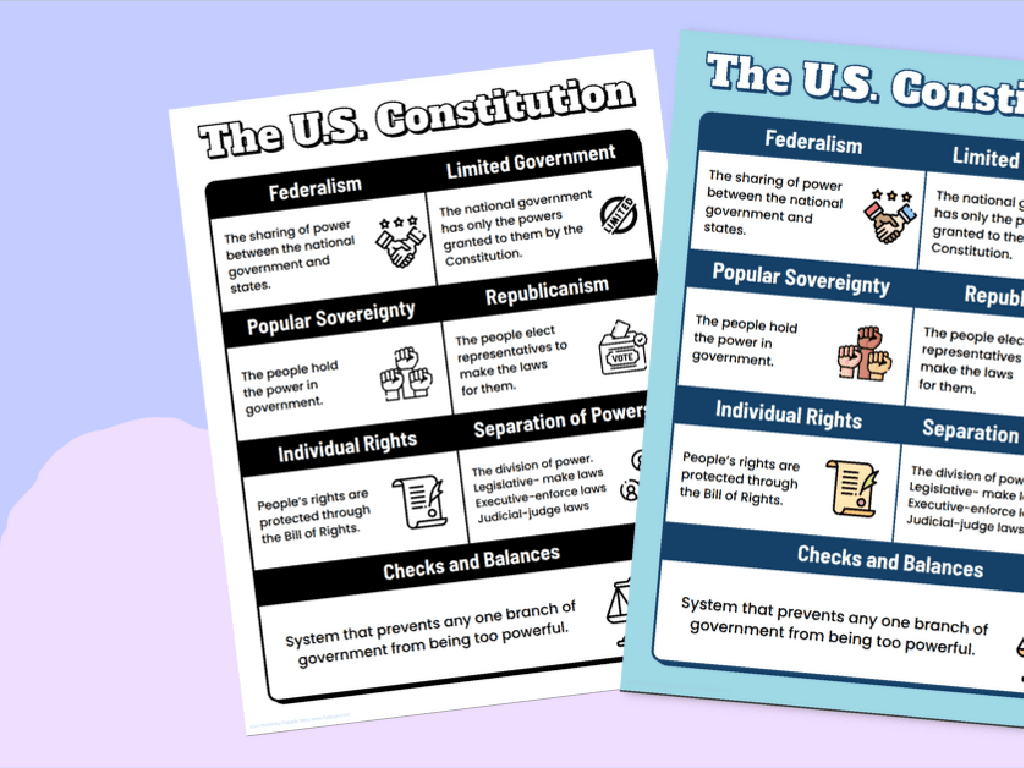Citizenship And The Naturalization Process
Subject: Social studies
Grade: Seventh grade
Topic: Citizenship
Please LOG IN to download the presentation. Access is available to registered users only.
View More Content
Welcome to Citizenship
– What does citizenship mean?
– Being a citizen means being a member of a country with certain rights and duties.
– Citizens’ rights and responsibilities
– Rights like voting and responsibilities like obeying laws.
– Overview of naturalization
– Naturalization is the process non-citizens go through to become citizens.
– Significance of becoming a citizen
|
This slide introduces students to the concept of citizenship within the context of social studies. Begin by discussing what it means to be a citizen, emphasizing the legal and emotional aspects of belonging to a country. Then, explore the rights that citizens have, such as voting and freedom of speech, as well as their responsibilities, including following laws and serving on juries. Introduce the naturalization process, explaining the basic steps such as application, interview, and oath ceremony. Highlight the importance of this process for individuals who choose to become citizens and how it strengthens the diversity and fabric of the nation. Encourage students to think about what citizenship means to them and to people around the world.
Exploring Citizenship
– Define citizenship
– Membership in a country with rights & duties
– Ways to become a citizen
– Birth, descent, marriage, and naturalization
– Birthright citizenship
– Granted if born in the country or to citizen parents
– Naturalization process
– Legal process for a non-citizen to become a citizen
|
This slide introduces the concept of citizenship, a status that entails both rights and responsibilities within a country. Discuss the various ways one can become a citizen, emphasizing the difference between acquiring citizenship by birth (jus soli or jus sanguinis) and through the naturalization process. Birthright citizenship is automatic, while naturalization requires an application, meeting certain criteria, and often a citizenship test. Use examples to illustrate these paths, such as a person born on U.S. soil versus someone moving to the U.S. and applying for citizenship. Encourage students to think about the meaning of being a citizen and the process involved in becoming one if not born with the status.
Rights of a Citizen in the U.S.
– Fundamental rights for citizens
– Rights are protected by the Constitution
– Freedom of speech, religion, press
– Express opinions, practice faith, inform public
– Right to vote in elections
– Voting is a key democratic privilege
– Participation in government
– Engage in political activities, run for office
|
This slide aims to educate seventh-grade students on the basic rights that are guaranteed to U.S. citizens under the Constitution. These rights include freedom of speech, which allows individuals to express their opinions; freedom of religion, which permits citizens to practice their faith freely; and freedom of the press, which enables the media to inform the public without censorship. Additionally, the right to vote is a fundamental aspect of democracy, allowing citizens to have a say in their government. Participation in government can take many forms, from voting to running for office. It’s crucial for students to understand these rights to appreciate the responsibilities and privileges of citizenship. Encourage students to think of ways they can participate in their community and government, even at their age.
Responsibilities of a U.S. Citizen
– Comprehend civic duties
– Civic duties include jury service and staying informed.
– Recognize the importance of voting
– Voting is crucial for democracy and representing our voices.
– Adhere to laws and taxation
– Laws maintain order; taxes fund public services.
– Uphold community and nation
|
This slide aims to educate seventh-grade students on the fundamental responsibilities that come with being a citizen of the United States. It’s important to instill an understanding of civic duties, such as serving on a jury and participating in the democratic process by staying informed about current events. Emphasize the importance of voting as a means for citizens to express their opinions and influence government decisions. Discuss the obligation to obey laws, which are in place to ensure a safe and orderly society, and the necessity of paying taxes to support communal resources and services. Encourage students to think about how they can contribute to their community and country, even at their age, by being engaged and responsible members of society.
The Naturalization Process
– Steps to naturalized citizenship
– Learn the process from application to oath
– Eligibility for naturalization
– Must meet criteria like age, residency, and moral character
– The naturalization interview
– An interview to assess eligibility and knowledge
– Understanding the citizenship test
– Test covers U.S. history, government, and English skills
|
This slide aims to outline the journey towards becoming a U.S. citizen through naturalization. Start by discussing the step-by-step process, from filing the application to taking the Oath of Allegiance. Highlight the eligibility requirements, such as being at least 18 years old, a lawful permanent resident for a certain number of years, and having good moral character. Explain the purpose of the naturalization interview, where officials review the application and assess the applicant’s understanding of English and U.S. civics. Lastly, delve into the citizenship test, which evaluates the applicant’s knowledge of U.S. history and government, as well as their ability to read, write, and speak English. Encourage students to discuss what they think are the most challenging parts of the process and why it’s important to have such a process in place.
Preparing for the Naturalization Test
– Overview of the civics test
– It’s a required interview to assess your knowledge of U.S. history and government.
– Examples of test questions
– ‘Who was the first President?’ or ‘What do the stripes on the flag represent?’
– Study strategies for success
– Review study materials, take practice tests, and stay informed on current events.
– Resources for test preparation
– Use official guides, online practice tests, and community classes.
|
The naturalization test is a crucial step in the process of becoming a U.S. citizen. It includes an English and civics test. The civics test covers important U.S. history and government topics. Provide students with sample questions and discuss the correct answers to give them a sense of what to expect. Share effective study tips, such as creating flashcards, joining study groups, or attending citizenship classes. Highlight resources available from the U.S. Citizenship and Immigration Services (USCIS) and other organizations. Encourage students to be thorough in their preparation and to practice regularly to build confidence for the test.
Citizenship in Our Community
– Being an active community citizen
– Engage in local events, volunteer, and stay informed
– Community service examples
– Cleaning parks, helping at shelters, or organizing charity events
– Student involvement in community
– Join school clubs, start a recycling program, or support local causes
– Discussing community contribution
|
This slide aims to inspire students to become active citizens within their own community. Discuss the importance of staying informed about local issues and participating in community events. Provide examples of community service such as park cleanups or volunteering at local shelters. Encourage students to think about how they can get involved, perhaps through school clubs or initiatives like recycling programs. Open a discussion for students to brainstorm ways they can contribute to their community, fostering a sense of responsibility and civic engagement.
Role-Play: Naturalization Interview
– Students simulate a naturalization interview
– Alternate roles: interviewer and applicant
– Engage in the role-play activity
– Use provided questions and scenarios
– Discuss and reflect on the experience
– Share feelings, learnings, and ask questions
|
This class activity is designed to give students a practical understanding of the naturalization process through role-play. Each student will have the opportunity to act as both an interviewer, representing a government official, and an applicant for U.S. citizenship. Provide a set of questions that are typically asked during a naturalization interview. After the role-play, lead a discussion where students can provide feedback on their experience, share what they’ve learned, and ask questions. This will help them empathize with individuals going through the process and better understand the responsibilities and privileges of citizenship. Possible variations of the activity could include different scenarios or unexpected questions to simulate the real-life unpredictability of such interviews.






